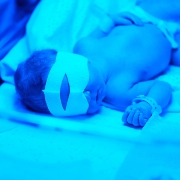
Do not put infants in direct sunlight. Due to their relatively thinner skin, infants under 6 months should be covered to avoid direct sun exposure. Dress your infant in: lightweight long pants long-sleeved shirts brimmed hats that shade the neck When adequate clothing and shade are not available, parents can apply a minimal amount of … Continue reading “Sun Exposure”

Newborn and infant skin is very sensitive, and rashes are common. Normal rashes include: Heat rash—a fine red rash mostly seen on the upper chest and diaper area. Avoid over wrapping your baby and use fragrance-free lotion if the skin is dry. Erythema Toxicum—red blotches with tiny white bumps in the center. It appears a … Continue reading “Skin”

Jaundice is a common condition that causes your baby’s skin to turn yellow. It normally develops on their face and in their eyes on day 2-3 of life. All babies are tested for jaundice prior to leaving the newborn nursery. Normally, jaundice peaks on day 4-5 of life and resolves within a few weeks. Jaundice … Continue reading “Jaundice”

During the first month your baby will grow rapidly—about 5 to 7 ounces per week, or a pound of weight gain every 2-3 weeks. Normal newborn skin looks “leathery” or dry and will soon peel with very soft skin underneath, requiring no treatment. Newborns also have very fine hair covering their shoulders, back and other … Continue reading “First Month: Physical Appearance & Growth”

The most common birthmarks on newborns are flat, tan spots and salmon patches. Salmon patches are red patches found on the eyelids, the center of the forehead and back of the neck, which usually fade during the first year of life. Be sure to discuss any other birthmark with your pediatrician. Read More: HealthyChildren.org

Article at a Glance